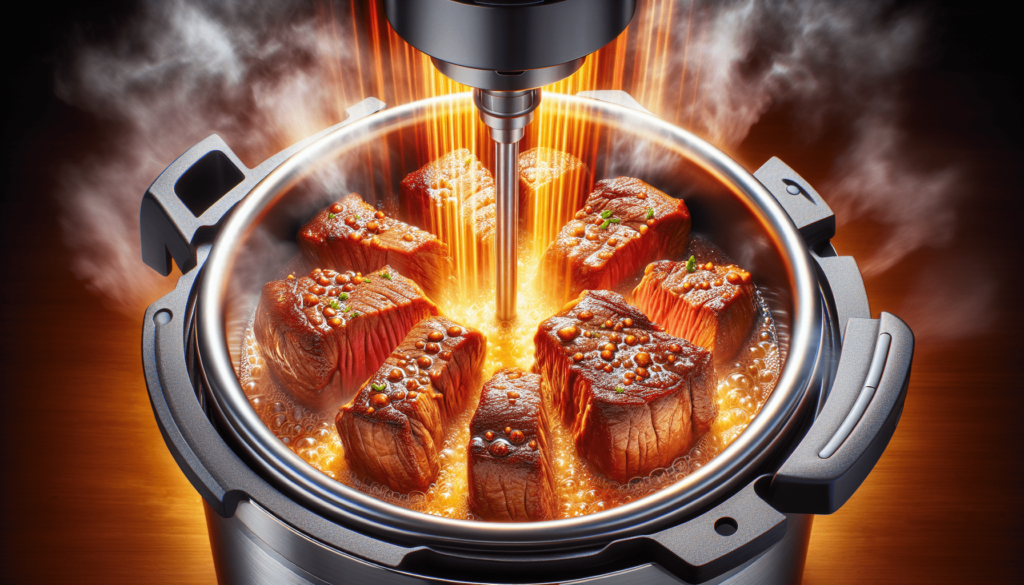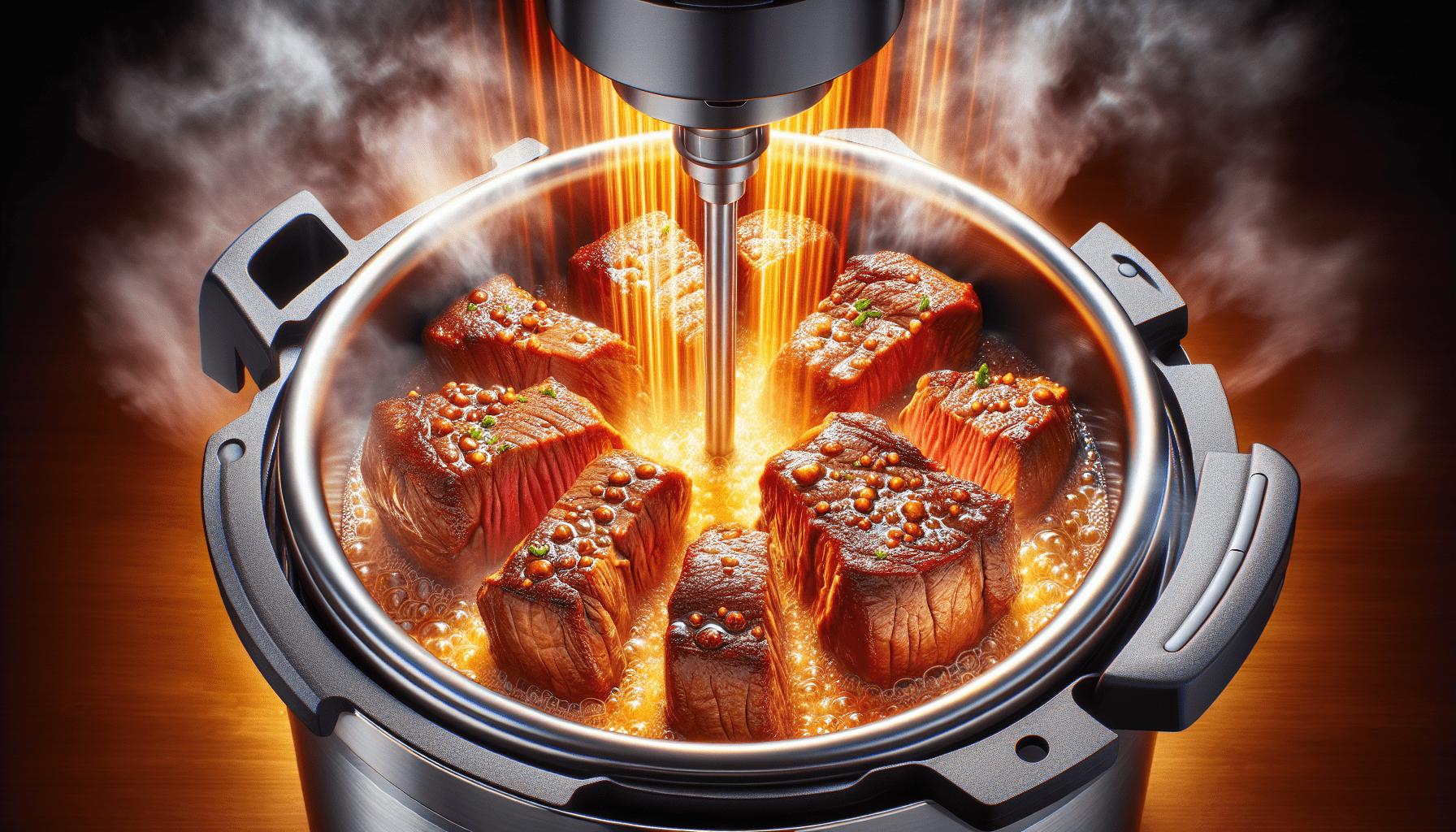In the world of cooking, the Instant Pot has revolutionized the way we prepare meals. With its multi-functional capabilities, it has become a kitchen staple for many. However, one question that often arises is whether or not it is possible to sauté meat in an Instant Pot before pressure cooking. Today, we are here to put any doubts to rest and provide you with the answer you’ve been seeking.

Benefits of Sautéing Meat in Instant Pot
Sautéing meat in an Instant Pot offers several benefits that can enhance your cooking experience. Let’s explore these benefits in more detail.
Promotes Browning
One of the key benefits of sautéing meat in an Instant Pot is that it promotes browning. The high heat from the sauté function helps to caramelize the proteins and sugars on the surface of the meat, resulting in a delicious golden-brown color. This browning adds depth and complexity to the flavor profile of the meat, giving it an appetizing appearance.
Enhances Flavor
Sautéing meat in an Instant Pot also enhances the flavor of the final dish. When meat is sautéed, the Maillard reaction occurs, which is a chemical reaction between amino acids and sugars. This reaction produces new flavors and aromas, resulting in a more robust and savory taste. By sautéing the meat before pressure cooking, you’ll infuse the dish with delicious flavors that will permeate throughout.
Adds Texture
In addition to promoting browning and enhancing flavor, sautéing meat in an Instant Pot adds texture to your dishes. The high heat of the sauté function helps to create a desirable crust on the outside of the meat, giving it a satisfying crunch. This contrast in texture makes each bite more enjoyable and provides a delightful mouthfeel.
Considerations Before Sautéing Meat in Instant Pot
Before you start sautéing meat in your Instant Pot, there are a few important considerations to keep in mind. Let’s go over these considerations to ensure you achieve the best results possible.
Type of Meat
The type of meat you choose to sauté in your Instant Pot is crucial. Different meats have varying cooking times and textures, so it’s essential to select the right cut for your recipe. For example, lean cuts of meat like chicken breast or pork tenderloin may require shorter sautéing times compared to fattier cuts like beef chuck or lamb shoulder. Consider the specific characteristics of the meat you’re using to determine the optimal sautéing time.
Amount of Meat
The amount of meat you sauté in your Instant Pot will also affect the overall cooking process. It’s important not to overcrowd the pot, as this can prevent proper browning and lead to uneven cooking. If you have a large batch of meat, consider sautéing it in smaller batches for better results. This will allow each piece of meat to come into direct contact with the heated surface, ensuring even browning and cooking.
Sautéing Time
The sautéing time can vary depending on the thickness and type of meat you’re cooking. Thicker cuts may require longer sautéing times to ensure the meat is properly browned and cooked through. On the other hand, thinner cuts may require less time to avoid overcooking. It’s important to closely monitor the meat as it sautés and adjust the time accordingly. Keep in mind that sautéing times can also vary based on personal preference, as some individuals prefer a deeply caramelized exterior while others prefer a lighter sear.
Step-by-Step Guide to Sautéing Meat in Instant Pot
Now that we’ve covered the benefits and considerations of sautéing meat in an Instant Pot, let’s delve into the step-by-step guide on how to accomplish this technique.
Preparation
Before you start sautéing meat in your Instant Pot, make sure to properly prepare the ingredients. Begin by selecting a suitable cut of meat that will complement your desired recipe. Ensure that the meat is trimmed of any excess fat or connective tissue. This will help prevent excessive splattering during the sautéing process.
Selecting the Sauté Function
Once you have your meat prepared, it’s time to select the sauté function on your Instant Pot. This function allows you to heat the pot to a high temperature, allowing for proper browning of the meat. Depending on your model, you may need to press a specific button or select the sauté option from the menu.
Adding Oil and Meat
After activating the sauté function, add a small amount of oil to the Instant Pot. The oil will aid in browning the meat and prevent it from sticking to the surface. It’s recommended to use an oil with a high smoke point, such as vegetable oil, canola oil, or avocado oil. Swirl the oil around the pot to ensure even coverage, then carefully add the meat.
Sautéing the Meat
Once the meat is in the pot, use tongs or a spatula to sear it on all sides. Allow each side to develop a golden-brown crust before turning it over. This process may take a few minutes, depending on the thickness and type of meat. Pay close attention to the heat and adjust it if necessary to prevent burning or undercooking. Once the meat is evenly browned, you can proceed with your chosen recipe, whether that’s pressure cooking, braising, or any other cooking method.
Tips for Successful Sautéing in Instant Pot
To ensure successful sautéing in your Instant Pot, follow these helpful tips:
Use High Heat Setting
For optimal browning and texture development, use the highest heat setting available on your Instant Pot. This will give the meat a nice sear and caramelization.
Cut Meat into Small Pieces
If you’re sautéing a large piece of meat, consider cutting it into smaller, more manageable pieces. This will allow for better surface contact with the heated pot and facilitate more even browning.
Pat Dry the Meat
Before adding the meat to the Instant Pot, pat it dry with paper towels. Excess moisture can interfere with the browning process, so removing any surface moisture will help achieve a better sear.
Avoid Overcrowding the Pot
To ensure even cooking and browning, avoid overcrowding the Instant Pot. Cook the meat in batches if necessary, allowing each piece enough space to come into direct contact with the heated surface.
Potential Concerns with Sautéing Meat in Instant Pot
While sautéing meat in an Instant Pot offers numerous advantages, there are a few potential concerns to be aware of. Let’s discuss these concerns and learn how to address them.
Splattering of Hot Oil
Sautéing meat in a hot Instant Pot can result in splattering of hot oil. This can be dangerous and cause burns if not properly managed. To prevent splattering, make sure the meat is dry and remove any excess moisture. Additionally, use caution when adding the meat to the hot oil, placing it gently to avoid splashing. Wearing protective gloves or using a splatter screen can also help mitigate this risk.
Risk of Overcooking
Another concern when sautéing meat in an Instant Pot is the risk of overcooking. The high heat of the sauté function can quickly cook the surface of the meat, leading to toughness or dryness if not monitored closely. It’s essential to keep a watchful eye on the meat and adjust the sautéing time as needed. Some trial and error may be required to achieve the desired level of doneness.
Cleaning the Pot Afterwards
The final concern with sautéing meat in an Instant Pot is the cleaning process afterward. The high heat and browning can cause food particles to adhere to the pot’s surface, making it more challenging to clean. To make the cleaning process easier, allow the pot to cool down before washing, and use a non-abrasive sponge or brush. Soaking the pot in warm, soapy water can also help loosen any stubborn residue.
Benefits of Sautéing Meat before Pressure Cooking
Sautéing meat before pressure cooking has several advantages that can elevate your dishes to new heights. Let’s explore these benefits further.
Sealing in Juices
Sautéing meat creates a flavorful crust that helps seal in the meat’s juices during pressure cooking. This extra layer of protection ensures that the meat remains juicy and tender, even under the intense pressure created within the Instant Pot. The result is a succulent and flavorful dish that will impress all who taste it.
Developing Richer Flavors
The act of sautéing meat enhances the natural flavors and aromas of the ingredients. As the proteins and sugars on the meat’s surface caramelize, new compounds are formed, resulting in a richer and more complex taste profile. This enhancement of flavors is carried over to the pressure cooking phase, infusing the entire dish with a depth and intensity that can only be achieved through this two-step process.
Creating a Crisp Exterior
Another benefit of sautéing meat before pressure cooking is the creation of a crisp exterior. The high heat of the sauté function produces a desirable crust that provides a pleasant contrast to the tender interior of the meat. This textural interplay makes each bite more enjoyable and adds a layer of sophistication to your dishes.
Pressure Cooking Times for Sautéed Meat
When pressure cooking sautéed meat, it’s important to adjust the cooking time accordingly to achieve the desired level of doneness. Let’s explore how to determine the right cooking time for your sautéed meat.
Adjusting Cooking Time
When transitioning from sautéing to pressure cooking, you will need to adjust the cooking time based on the recipe and desired outcome. The sautéing process partially cooks the meat, so less time will be needed during the pressure cooking phase. It’s recommended to reduce the original pressure cooking time by approximately 15-20% when working with sautéed meat. However, it’s essential to consult specific pressure cooking recipes for accurate timing guidelines.
Considering Meat Thickness
The thickness of the sautéed meat will also influence the pressure cooking time. Thicker cuts will require longer cooking times to ensure that they are thoroughly cooked and tenderized. Conversely, thinner cuts may require less time to reach the desired level of doneness. When determining the pressure cooking time, consider the thickness of the meat and adjust accordingly.
Checking Doneness
To ensure that your sautéed meat is cooked to perfection, it’s crucial to check for doneness using a food thermometer. Different types of meat have specific internal temperature guidelines for safe consumption. Insert the thermometer into the thickest part of the meat, away from any bones or fatty areas, and ensure it reaches the recommended temperature. This step will guarantee that your sautéed meat is not only flavorful but also safe to eat.
Recipes for Sautéed Meat in Instant Pot
Now that you’re aware of the benefits, techniques, and considerations for sautéing meat in an Instant Pot, let’s explore a few delicious recipes that you can try out.
Sautéed Chicken with Herbs
Ingredients:
- 4 boneless, skinless chicken breasts
- 2 tablespoons olive oil
- 2 garlic cloves, minced
- 1 teaspoon dried thyme
- 1 teaspoon dried rosemary
- Salt and pepper to taste
Instructions:
- Heat your Instant Pot using the sauté function and add the olive oil.
- Season the chicken breasts with salt, pepper, thyme, and rosemary.
- Carefully place the chicken breasts into the Instant Pot and sauté for 2-3 minutes on each side, or until golden brown.
- Remove the chicken from the Instant Pot and set aside.
- Add the minced garlic to the pot and sauté for 1 minute, until fragrant.
- Return the sautéed chicken breasts to the Instant Pot, cover with the lid, and switch to the pressure cooking function.
- Set the pressure cooking time according to the recipe you’re following and cook until the chicken reaches the recommended internal temperature.
- Once cooked, release the pressure and serve hot, garnishing with fresh herbs if desired.
Sautéed Beef with Vegetables
Ingredients:
- 1 pound beef sirloin, cut into thin strips
- 2 tablespoons vegetable oil
- 1 onion, sliced
- 2 bell peppers, sliced
- 2 garlic cloves, minced
- 1 tablespoon soy sauce
- 1 tablespoon Worcestershire sauce
- Salt and pepper to taste
Instructions:
- Select the sauté function on your Instant Pot and add the vegetable oil.
- Add the beef strips to the pot and sauté for 2-3 minutes, or until browned on all sides.
- Remove the beef from the Instant Pot and set aside.
- In the same pot, add the onions and bell peppers and sauté for 3-4 minutes, or until softened.
- Add the minced garlic and sauté for an additional minute, until fragrant.
- Return the beef to the pot and stir in the soy sauce and Worcestershire sauce.
- Season with salt and pepper to taste.
- Cover the Instant Pot with the lid and switch to the pressure cooking function.
- Set the pressure cooking time according to your recipe and cook until the beef is tender.
- Once done, release the pressure and serve the sautéed beef and vegetables over rice or noodles.
Sautéed Pork Tenderloin with Apple Compote
Ingredients:
- 1 pork tenderloin
- 2 tablespoons olive oil
- 2 apples, peeled and sliced
- 2 tablespoons brown sugar
- 1 teaspoon cinnamon
- 1/4 teaspoon nutmeg
- Salt and pepper to taste
Instructions:
- Heat the Instant Pot using the sauté function and add the olive oil.
- Season the pork tenderloin with salt and pepper.
- Sear the pork in the Instant Pot for 2-3 minutes on each side, or until browned.
- Remove the pork from the pot and set aside.
- Add the sliced apples to the pot and sauté for 2-3 minutes, until slightly softened.
- Stir in the brown sugar, cinnamon, and nutmeg, coating the apples evenly.
- Return the pork to the pot and cover with the lid.
- Switch to the pressure cooking function and set the cooking time according to your recipe.
- Once the pork is cooked, release the pressure and remove the pork and apples from the pot.
- Let the pork rest for a few minutes before slicing.
- Serve the sautéed pork tenderloin with the apple compote on the side, garnishing with fresh herbs if desired.
FAQs about Sautéing Meat in Instant Pot
Here are some frequently asked questions about sautéing meat in an Instant Pot:
Can I Sauté Frozen Meat?
While it is technically possible to sauté frozen meat in an Instant Pot, it is not recommended. Sautéing requires high heat to achieve proper browning, which can be challenging when working with frozen meat. To ensure even cooking and avoid potential food safety risks, it is best to thaw the meat thoroughly before sautéing it in an Instant Pot.
What Types of Oil Can I Use?
You can use a variety of oils for sautéing meat in an Instant Pot, depending on your personal preferences and the flavor profile you wish to achieve. Oils with high smoke points, such as vegetable oil, canola oil, and avocado oil, are commonly used due to their ability to withstand high heat without burning or imparting an overpowering taste. Experiment with different oils to discover the flavors that best complement your recipes.
Can I Sauté Fish or Seafood?
Yes, you can sauté fish or seafood in an Instant Pot. However, it’s important to exercise caution as seafood tends to cook quickly and can easily become overcooked or dry. Reduce the sautéing time compared to meat, ensuring that you monitor closely to prevent overcooking. The sautéed fish or seafood can then be pressure cooked for a shorter duration, just until it reaches the recommended internal temperature.




